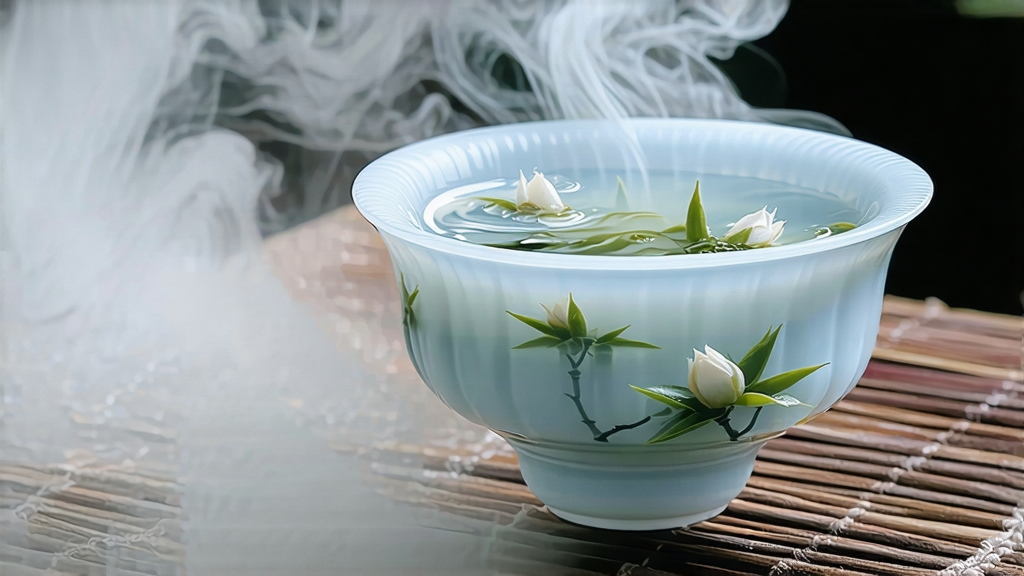
Among the six great families of Chinese tea, white tea is the least theatrical yet the most elusive; it is oxidised by nothing more than air, time, and the patience of its maker. Within that family, Bai Hao Yin Zhen—literally “White-Hair Silver Needle”—occupies the highest rung, the one that brushes the clouds. International drinkers often meet white tea through bagged “pai mu tan” or flavoured blends, but to understand the genre one must begin with the pure, unblended elegance of Silver Needle. This essay invites you to travel with a single bud: from the pre-dawn gardens of northern Fujian, through forty-eight hours of silent withering, into your own teapot, and finally onto the palate where it dissolves into a flavour that Chinese poets describe as “the taste of moonlight on snow.”
-
A brief, misty history
White tea is not “unprocessed”; rather, it is the tea whose processing is closest to nature. The first written record appears in Song dynasty treatises (960-1279 CE) that praise “white tablets” pressed as tribute cakes. Those cakes, however, were green tea that happened to bear white down; true white tea as we now define it—leaves dried without pan-firing—emerged in the late eighteenth century around Taimu Mountain, Fujian. By 1796, local chronicles note that “tea buds, picked before Qingming, are spread on bamboo and allowed to wither in mountain wind, then baked gently over charcoal embers.” The name Yin Zhen itself was bestowed during the Xianfeng reign (1851-1861) when the needles were chosen for imperial tribute; each chest was sealed with paper bearing the emperor’s dragon, and only the most perfect buds—straight, silver, and unopened—were accepted. Thus Silver Needle is both ancient and surprisingly young, a child of Qing ingenuity rather than Tang myth. -
Terroir: why Fuding matters
All Silver Needle is white tea, yet not all white tea qualifies as Silver Needle. Chinese law restricts the name to buds plucked from specific cultivars—Fuding Da Bai, Fuding Da Hao, and Zhenghe Da Bai—grown within the protected geographical indication of northeast Fujian. The region’s red granitic soil is poor in nitrogen but rich in potassium, forcing the bush to channel nutrients into fewer, more resinous buds. A subtropical maritime climate supplies 1,800 mm of rain annually, but morning fog slows evaporation, allowing the bud to grow longer, fatter, and cloaked in a down that chemists identify as mostly cellulose and protective trichomes. These hairs trap aromatic volatiles that survive the minimal processing, giving the tea its signature “hao xiang” (down fragrance). Attempts to reproduce Silver Needle in Yunnan or Sri Lanka yield pretty buds but flatter aroma: the terroir is stubborn. -
The cultivar: Fuding Da Bai
Developed in 1857 from a single mother bush found near Tai Lao village, Fuding Da Bai is a small-tree varietal whose spring buds can reach 3.5 cm, plump as a sparrow’s tongue. Its leaf chemistry is unusual: 4.8 % L-theanine (almost double that of Assam bushes) and a low catechin-to-theaflavin ratio, explaining the tea’s umami sweetness and pale liquor. Farmers prune the bush into an umbrella shape that encourages vertical shoots; only the axial bud—the one that points like a spear at the sky—is harvested. One kilogram of finished Silver Needle demands roughly thirty-eight thousand such buds, all picked before the Qingming festival when night temperatures still drop to 8 °C, concentrating amino acids. -
Craft: the art of doing almost nothing
Silver Needle is made in four quiet steps: pluck, wither, sort, dry. Yet within each step lie micro-decisions that separate mediocrity from transcendence.
a) Pluck: begins at 5 a.m. while dew is still a liquid pearl. Finger and thumb snap the bud without squeezing; any bruise will oxidise into an unsightly red tip.
b) Withering: the buds are laid on reed trays stacked like shelves in a mountain pavilion. For forty-eight hours they rest in diffused light and steady breeze (